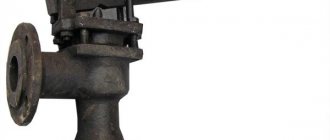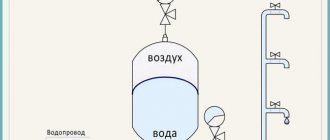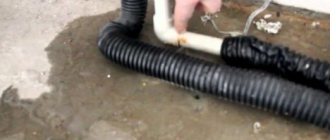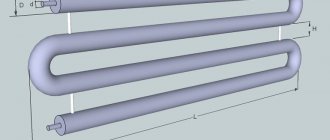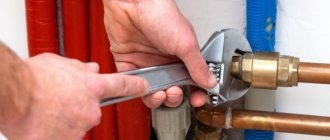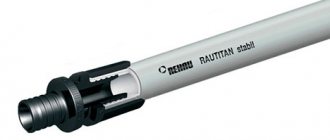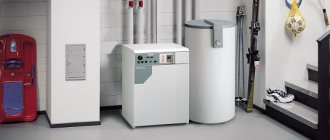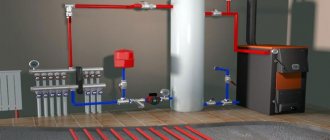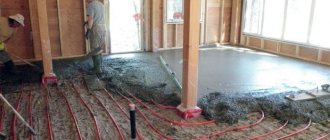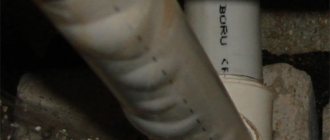Causes
Knowing what water hammer is in a water supply system, it is easy to identify the reasons for its occurrence. In this case, it is necessary to distinguish between negative and positive hydraulic shocks. The first occurs when water with high pressure enters a section of a pipeline with a sharply reduced liquid pressure. The second, more dangerous in their consequences, arise when pressure increases due to a rapid abrupt increase in the speed of its flow or, conversely, a stop. In practice this happens due to:
- sudden closure of valves or taps;
- turning on or off pumping equipment (including situations associated with a power outage);
- air jams;
- availability of pipes of different diameters.
It is worth noting that with the spread of ball designs of valves and faucets, the wear of water pipelines due to pressure shock has become more significant. Unlike the classic screw design, the ball design requires significantly less time for opening/closing shut-off valves. To do this, just turn the handle 90 degrees with one movement of your hand. And this, of course, is faster than several turns of the valve.
Ball and valve shut-off valves for hot and cold water supply pipelines Source nurai-invest.kz
The likelihood of water hammer is higher the longer the pipeline and the greater the potential volume of liquid that can collect in front of the shut-off valves or at the narrowing of the pipes.
See also: Catalog of companies that specialize in the calculation and installation of water supply and sewerage systems.
What is water hammer, and what is the nature of this phenomenon.
The pipes of the heating and plumbing system, especially in a private home, sometimes make strange sounds. Sometimes they are noticed, but ignored. But in vain. Clicks and knocks in pipelines can also indicate water hammer in the water supply system. Perhaps it's time to take measures to prevent them before the question arises: who is to blame for a sudden pipe burst...
What is water hammer
Water hammer is a powerful short-term increase in the pressure of a liquid circulating in pipes, resulting from a sharp change in the speed of its movement. Depending on the sign of the change in pressure, water hammers are divided into: – positive, aimed at increasing pressure, which occur when valves are suddenly closed or pumping units are turned on;
– negative, associated with stopping the pumps.
Visual demonstration of water hammer in a pipe
Let's consider what it is - water hammer, and what is the nature of this phenomenon.
When the valve is suddenly closed, the flow of water does not stop completely, and not immediately. The layers of water closest to the valve stop, while the rest continue to move by inertia. They collide with a layer frozen in place, and those following collide with them.
The same thing happens if you suddenly close the entrance to the escalator in the subway while a stream of people is passing through. The first rows stop, others press on them, and the next ones press on them. There is a crush. The same thing happens with water hammer.
Important: When the flow of liquid suddenly stops, the pressure in the pipeline instantly increases significantly, reaching tens of atmospheres. The expectation that this will remain without consequences is unlikely to be justified.
Let's figure out why water hammer is dangerous.
What is the danger of water hammer
Any increase in pressure in the pipeline above the design value is dangerous both for the pipes themselves and for their connections. Shut-off valves may also be damaged.
This will not happen immediately, because initially all engineering systems, without exception, are carried out with a safety margin. But each water hammer methodically and mercilessly searches for a weak point in the pipeline, gradually preparing it for destruction. And at some point the patience of the pipes reaches a limit, and they burst.
An example of the consequences of water hammer
The consequences of breakthroughs are widely known. This is damaged furniture, wallpaper, carpets. Neighbors flooded with water, nervously demanding that everything be fixed as soon as possible, followed by payment of compensation for the damage caused.
If there was a water hammer in the heating system, then intangible victims are also possible. Hot coolant can cause serious burns to people who are unlucky enough to fall under its stream. And material losses from exposure to hot water are more serious than from cold water.
If the accident happened in severe frost (and breakdowns never happen), then stopping the heat supply will entail stopping the boiler with a complete freeze of the system.
It is easier to prevent losses than to compensate. To do this, you need to understand how to avoid them. So, water hammer in the water supply system, the reasons for its occurrence.
Causes of water hammer
Water hammers account for about 60% of all pipeline accidents that occurred with their direct participation. Most of them are due to worn out old pipes, which always have a weak spot.
The longer the pipe, the stronger the water hammer. This follows from its nature: more water fits in an extended pipeline, its weight can cause a more serious pressure drop. Therefore, the further away the shut-off valve is located, the more noticeable the water hammer in the pipeline. In this regard, the pipelines of water heated floors, the length of which is large, are most vulnerable.
To prevent underfloor heating from damage due to water hammer, the thermostatic valves that control their operation must be installed correctly. The circulation must be shut off at the entrance of the pipeline to the floor. In this case, after closing the valve, the water, although it continues to move by inertia, only creates a vacuum behind the valve that is not dangerous for the pipeline. It is practiced to simultaneously shut off the pipeline outlet with another valve.
In the old days, with the dominance of screw valves, water hammers occurred much less frequently. Closing the shut-off valves could not be done instantly; this required more than one turn of the handle. From a safe operation point of view, this is correct.
The advent of ball valves made it possible to perform the same operation much faster. The ease of movement of the handle and the achievement of the set goal by turning it only 90 degrees makes it tempting to practice the speed of closing the valve, which is absolutely not possible. As a result, a sudden stop in fluid flow tests the strength of the pipeline system.
But the valve does not have to be closed abruptly to cause a water hammer. If air is poorly displaced from the heating system, then when water interacts with it, opening the tap leads to a similar phenomenon. Water is difficult to compress, unlike air. The latter, in the event of a sharp collision with a liquid under pressure, acts as a kind of shock absorber, an elastic obstacle in its path.
The occurrence of water hammer is facilitated by the presence of “different-sized” pipes in the system. If pipelines of different diameters are not “reduced to a common denominator” using appropriate adapters, pressure surges during their operation are inevitable.
How to deal with water hammer
To protect water and heat supply systems from the effects of water hammer, a number of measures are used. Some of them are indicative of universal use, while some are used for pipelines for a specific purpose.
Smooth overlap
You need to get rid of the temptation to quickly cope with such a simple task as opening or closing a valve. This needs to be done slowly and smoothly. If the valve is tight, then it is allowed to move its handle with small jerks. This is customary at industrial enterprises, but it is indicative of implementation in everyday life.
To avoid water hammer, it is recommended to close the ball valve smoothly.
Water hammer still occurs. But it breaks down into several smaller ones. The energy that affects the pipes once when the valve is suddenly closed is divided into portions that do not create strong pressure drops. And therefore - not dangerous..
Depreciation
By manually controlling the movement of fluid flows, they can be smoothly closed or opened. But thermostats, which automatically control the operation of the heating system, are not capable of this.
To soften the water hammer in the system, shock-absorbing devices are installed in it. Before installing the thermostat valve, part of the rigid pipeline is replaced with an elastic one. The materials used for this are either heat-resistant rubber or reinforced plastic.
Since these materials can stretch, at the moment of a water hammer they will absorb its force. By briefly increasing in diameter, the shock absorber will act as a damper and relieve pressure before the valve closes.
For most systems, installing a piece of elastic pipe of about 20–30 cm is sufficient. For long pipes, you can increase it by another 10 cm.
Bypass surgery
The method involves manual modification of thermal valves. To implement it, knowledge of their design is required, otherwise the device can only be damaged.
The shunt is a thin tube with a diameter of 0.2 - 0.4 mm. It is inserted into the valve in the direction of fluid flow. During operation, it does not in any way affect the performance of the system, but with a sharp increase in pressure it will help bleed it into the pipeline behind the valve.
Note: Such measures will only help in systems consisting of new pipelines, and preferably not made of metal. The presence of rust negates all efforts and tricks, as it will quickly clog the hole.
Instead of installing a tube, it is often enough to drill a hole of the appropriate diameter.
Protected thermostats
The industry produces thermostats equipped with a water hammer protection device. They have a spring mechanism installed between the valve and the thermal head. You can find out about the availability of this device when purchasing a thermostat from its technical documentation.
When the pressure is exceeded, the spring stretches and prevents the valve from closing completely. The same process occurs as with shunting - excess pressure is released into the pipeline behind the valve. When the water hammer stops, the spring will completely close the valve.
Important: Thermostats equipped with a water hammer protection system are installed into the system strictly in one direction, indicated by the arrow on the housing.
Compensators
One of the compensating devices used in heating systems (it is also suitable for water supply) to protect against water hammer is a hydraulic accumulator. It is a reservoir divided into two parts by a flexible membrane made of rubber or caoutchouc.
At the bottom of the tank, connected to the system, there is water. The top contains air under pressure. A product of a similar design is part of an automatic pumping station and is used there to turn off the pump when the nominal pressure in the system is reached.
As part of the heating system, the compensator is connected to places where water hammer may occur. At this moment, the increasing fluid pressure presses on the accumulator membrane. The air above it is compressed, the membrane moves towards it. Due to the increase in the volume occupied by the liquid, the pressure in it drops.
As soon as the impact of the water hammer ends, the membrane returns to its place. The use of hydraulic accumulators simultaneously allows you to remove excess fluid from the system.
To create a shock-absorbing effect in water supply systems, in addition to hydraulic accumulators, special dampers are used.
Compensator device.
Safety valves
Once upon a time, doctors performed bloodletting on patients with high blood pressure. Less fluid means less pressure. Safety valves work on the same principle.
They are placed in the most dangerous places subject to water hammer. They work either as independent devices, or from a command from a controller that controls the operation of the system and has information about the pressure in it at given points.
As soon as the pressure at the installation site of the safety valve exceeds the threshold level, it will open and throw excess liquid out. Naturally, this happens where they will not cause harm or discomfort to anyone.
As the pressure decreases, the valve will close, returning to its original state.
Relief safety valve
Automatic control devices
Don't focus only on valves and valves. Starting and stopping pumps also provokes water hammer in the water supply system. The more powerful the pump, the stronger the water hammer.
The pressure created by the pumping unit depends on the rotation speed of its electric drive - the engine. When voltage is applied to it, it accelerates almost instantly. If you force it to do this smoothly, then water hammer when you turn on the pump can be avoided.
The rotation speed of the electric motor depends on the voltage or frequency of the supply network. It is unlikely that you will be able to regulate the speed by changing the voltage. But changing the frequency helps achieve the desired effect.
For this purpose, special motor control devices are used: frequency converters and soft starters. Both of them, upon receiving a start command, smoothly increase the power supply frequency of the electric motor, bringing it to rated speed within a time pre-set during system setup. Water hammer disappears.
But frequency converters have another advantage. They allow the pump to regulate its performance during operation so that its optimal operating mode is maintained. The fluid pressure can be changed not by the degree of opening of the outlet valve, but by the rotational speed of the electric motor.
To do this, pressure sensors or any other parameter are connected to the frequency converter, which it will maintain within specified limits, changing the pump speed. At the same time, there is also an economic benefit: energy consumption is reduced, since the pump will consume exactly as much energy from the network as necessary.
Disadvantages of a frequency converter: high cost and the need for adjustment work to be performed by a specialist.
If your heating or water supply system is not yet equipped with any of the devices described above, and it shows signs of water hammer, it’s time to modernize it. Otherwise, someday you will have to take on repairs.
Share:
Consequences of water hammer
Any incidents with the water supply are associated not only with material damage to the pipeline itself, but also with the costs of eliminating the consequences of water exposure to nearby objects. This is especially aggravated for pipelines with hot water and those under high pressure. In these situations, there is even a danger to the health and life of people and pets. They may be scalded or injured. In particular, this negative phenomenon may be followed by the following:
- destruction of pipe lines;
- flooding of residential, administrative and utility premises;
- failure of pumping equipment and shut-off valves;
- damage to furniture, household appliances, computers and the like;
- interruption of water supply;
- destruction of structures of buildings and structures (especially in winter, due to the force of expansion when moisture freezes);
- interruption of electrical supply;
- fires due to short circuit of electrical wiring.
Danger of consequences of damage to heating and water supply due to water hammer Source formp3life.ru
Accidents on highway networks can cause traffic congestion; in winter, icy conditions caused by gusts usually completely block the movement of cars for some time.
Prevention and protection
Prevention and protection against water hammer is based on two things. This is correct operation and direct protection against water hammer in the water supply system. The first primarily comes down to minimizing cases of instantaneous changes in flow speed due to incorrect human actions. To do this, all switching on and off of the pipeline must be done smoothly, ensuring a uniform change in pressure over a certain period of time. Preventive measures also include checking the system for leaks, regularly replacing and cleaning filters, and checking the functionality of water supply elements.
Technical means of protection
The system must be maximally protected from rash human actions, improper operation and untimely and incomplete maintenance. To achieve this, there are a number of technical solutions to minimize the consequences of fluid pressure surges in water supply and heating networks and prevent their occurrence.
Pipe replacement
To do this, it is necessary to inspect the entire pipeline; old steel pipes should be replaced with modern ones made of polymer materials. They are more reliable, practically resistant to corrosion and last longer. In this case, pipes must be selected taking into account operating conditions (pressure and temperature in the network) with a small margin in parameters. To reduce the flow rate, it is advisable to choose products with the maximum possible diameter for the pressure. Find a middle ground.
Modern reliable pipes and connecting elements made of polymer materials Source santehnika-nk.ru
Replacing shut-off valves
Replacing ball valves with valve valves can be called a return to the past, but this will avoid sudden pressure changes regardless of how the shut-off valves open and close. It is not necessary to change all locking devices; you can limit yourself to only those that are critical to the system.
A little about the renovation
With constant overvoltages occurring in pipelines, the need for repairs to the heating system often arises. Coolant leaks from the circuit occur through threaded connections, ruptures of the pipe or radiator elements along the seam.
There are 3 types of repairs:
- emergency. The need for it arises when the elements of the thermal circuit gradually wear out or in cases of a sharp increase in pressure. Performed in conditions where it is necessary to quickly restore the heat supply to the facility;
- current . It is carried out at the end of the heating season based on inspections by specialists of repair services and residents of residential premises. Worn parts are replaced, defects noticed during routine pressure testing of pipelines are eliminated;
- capital _ Complete or partial replacement of pipes, heating registers, circulation pump and other elements of the heating system is carried out.
We recommend: Cleaning a gas boiler from soot: step-by-step instructions
Compliance with the operating rules of the heating system will avoid its premature breakdowns. So, the circulation pump should smoothly accelerate and stop.
To avoid water hammer, taps should be turned off gradually, without abruptly interrupting the flow of water.
